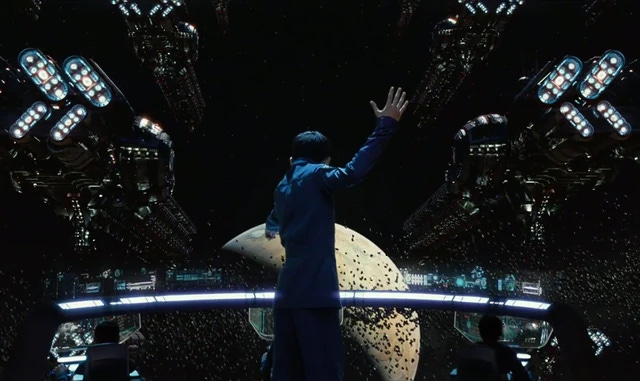[POST] You can't handle the truth!
Does America really want to be able to wage a long conventional war against other great powers?
This is a reader-supported publication. I give it all away for free but could really use your support if you want me to keep doing this.
You all know the lesson I am drawing from Russia-Ukraine: the pointlessness of conventional warfare as it is progressively transformed into a post-human battlespace.
The proof in Ukraine: a much smaller nation and its military thwarting the conventional invasion by a far larger nation and its military. That is what I mean by “forced by supreme asymmetry.” Russia came, in force, to capture a vast area, and Ukraine, relying heavily on drones, has denied Russia of that sought-after success, forcing a stalemate in which much — if not most — of the identifiable battlespace is actually too dangerous for troops to operate within.
When they can kill you in your bunk bed, the war is too dangerous for you, trooper.
Casualties in this war today: roughly 70% claimed by drones operated remotely by personnel — 1985’s Ender’s Game novel made real, not because it’s cool, as the capacity has been around for a while within the US military and was wielded many, many times across our Global War on Terror (see the 2005 film Syriana for the first great Hollywood capture of such high-value target killing using drones, later made real by the US assassination of the New Jersey imam Anwar al-Awlaki in 2011 — the first time a US president openly ordered the assassination of a US citizen operating abroad).
No, Ukraine has gone heavy-drone because its population is around 45m, compared to Russia’s 145m. So, no surprise, in a bloody war of attrition (Ukraine losing about 60k to-date and Russia losing arguably three times as many), Ukraine is having trouble recruiting young men to fight.
But, to play Ender’s Game? For that mission, operators can be found.
The novel Ender's Game is widely recognized as a remarkably prescient (as in, four decades ago) depiction of drone-operated warfare. The novel envisions a future where commanders, isolated from the battlefield, remotely direct fleets of unmanned ships using game-like interfaces, or basically what we see with drone warfare in Ukraine. Ender Wiggin, the hero of the story, commands entire fleets through screens and virtual environments, believing he is playing simulations, while in reality, he is orchestrating real battles from afar.
Repeating the fascinating photo from yesterday’s Cutdown post:
There’s your early version of Ender Wiggin. No, our drone pilot isn’t yet capable of steering entire fleets of attack vehicles, like our young warrior in the book (and movie), but someday soon…
Ukraine began its drone-heavy defense relying on foreign sources. Now, it has a domestic “industrial” base sufficient to crank out millions of drones annually.
Ukraine produced 2m drones last year and is on pace to produce 4.5m this year — or 95% of its drone force. Ukraine’s military is presently pursuing a path of adding AI to the mix, in effect, putting AI in the driver’s seat more and more. Current AI capacity is estimated to improve drone targeting by 3-4 fold.
It will only get far better with time.
To me, all this points to a future in which troops do not matter like they used to. Same with conventional ammunition. Same with conventional platforms — or basically my message as Assistant for Strategic Futures in the post-9/11 Office of Force Transformation in the Office of Secretary of Defense during the Global War on Terror (two decades after the book but two decades ahead of today).
Many in the West, in my mind, are drawing the wrong lessons from Ukraine, seeing the need to dramatically increase our conventional weaponry and ammunition production for future long wars — in effect, pushing us to emulate Russia in this fight instead of Ukraine.
The logic baffles me:
NYT: The U.S. Can’t Handle a War
The argument:
Over the past few decades Washington has traded a larger, more durable military force for one that is high-tech but brittle. Defense planners have made small quantities of expensive, cutting-edge weapons a priority over producing enough firepower for a long fight. This shift relied on advanced weapons having the power to end fighting decisively and quickly. Yet modern wars have evolved to require both advanced systems and sheer volume of 20th-century staple munitions, such as artillery shells and missiles.
As always with such developments, many US military analysts spot only the additional requirement and not the transformation. Here, they spot World War I (artillery) and World War X (drones, AI), and, naturally, the US must master BOTH to be able to take on all-comers from all angles:
There is no magic number of dollars that the United States should be spending on defense, but the resources we have now are not enough to meet the simultaneous challenges posed by China, Russia, Iran, North Korea and terror groups across the globe. The further our defense capabilities fall behind the risks we face, the more costly it will be to catch up.
“No magic number” is Pentagon code for unlimited spending — you know, like $1T ain’t enough, comrade!
The estimates from these analysts are intimidating: If America goes to war with China over Taiwan, it will exhaust portions of its ammunition supplies (like long-range anti-ship missiles) in about a week. But, of course, that vision presupposes the utility, feasibility, and desirability of fighting a massive conventional war against China for what? Months? Years?
Is that really a realistic standard? Or are we better off going down the path suggested by Ukraine — as in, anything you can conquer with conventional means, I can deny to you through AI-fueled drone warfare.
Isn’t that the better deterrence — and the more plausible deterrence? Doesn’t that path lend itself better to dual-use technologies for policing and public safety in general?
Per China’s quantum grand strategy of seeking to wire up and sensor as much of the Global South as possible to suck up all that big data to drive its AI supremacy, doesn’t it make more sense for us to win that competition versus spending all that time and money trying to cover WWI-like bets that seem beyond pointless?
FORBES: At The Current Rate, It Would Take Russia Centuries And Tens Of Millions Of Casualties To Capture Ukraine
David Axe, probably the best analyst today on drone warfare, points out the obvious in the Russian WWI-like approach to warfare: there’s just no way Russia can win out at this rate of expenditure.
Russian forces managed to capture around 68 square miles of Ukraine in April. But it cost them 4,800 vehicles and more than 36,600 dead and wounded troops, according to one statistician who collects data mostly from official Ukrainian sources including the general staff in Kyiv.
In the same month, Ukrainian losses were “minimal,” concluded analyst Konrad Muzyka of Rochan Consulting in Poland.
Ukraine sprawls across 233,000 square miles, 19% of which is under Russian occupation. At the current rates of advance and loss, the Russians would capture the rest of Ukraine in the year 2256 at the cost of 101 million casualties. The current population of Russia is 144 million.
Incredibly, staggering losses in people and equipment haven’t yet crippled the Russian military in Ukraine. The Kremlin is equipping its forces with thousands of civilian vehicles, including scooters, compact cars and even at least one bus.
Meanwhile, it’s recruiting 30,000 troops per month, Gen. Christopher Cavoli, commander of U.S. Army forces in Europe, told U.S. lawmakers on April 3. Since many of the wounded eventually return to the front line, the Russian armed forces recruit more people every month than they lose.
As a result, Cavoli said, the Russian force in Ukraine is actually growing. It now numbers no fewer than 600,000 troops, “the highest level over the course of the war and almost double the size of the initial invasion force” in February 2022, Cavoli said.
Again, why is God’s name would we want to emulate that approach by embracing its example as a force and material-sizing standard, applied to arguably the worst possible fight we could pick — namely, with China over an island nation just off its coast?
To me, that’s the wrong lesson for the wrong war, and yet, which contingency aren’t we seeking to cover with our new $1T defense bill? You know, the one our Neo-isolationist White House just proposed?
Does any of this make sense to you? We should emulate the Russian model of modern war … and we should apply that logic to the Taiwan scenario … because someday soon we’ll be selling a months-to-years-long knock-down-drag-out fight with China to an American public just itching to lose hundreds of thousands of US troops to defend Taiwan at all costs?
Take a deep breath, say I. Go with the Palantir and Anduril vision of tomorrow’s wars. Build a post-human military. Predict the future accurately by building it ourselves.
That is my truth. Handle it if you dare.
I know, I know … Barnett is once again dreaming of wars as he would prefer them versus how they really are.
Except Ukraine is showing us how wars really are today. We just need to draw the right lessons from the right side in that conflict.










